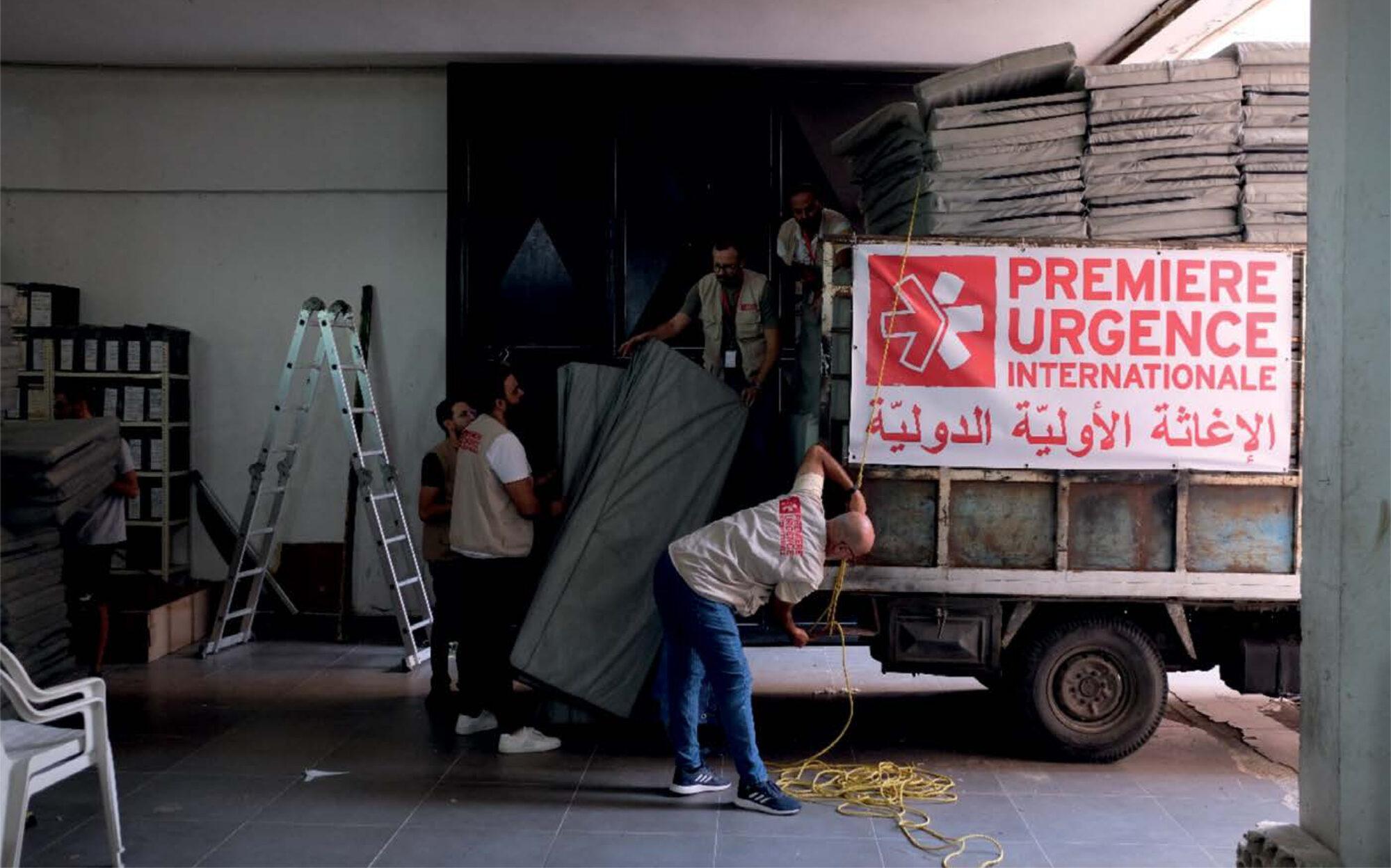Main content
Lebanon has long served as a refuge for populations running from persecution in the Middle East, due to its historical role as a sanctuary for displaced persons, and, more recently, as a result of its proximity to regional conflicts that have forcefully displaced huge numbers. As of 2023, Lebanon hosts over 1.5 million Syrian refugees, alongside smaller populations from Palestine, Iraq, and other countries.[1] Around one in every four people in Lebanon can be described as a refugee. Since the start of the war in Syria in 2011, the influx of refugees has weighed heavily on Lebanon’s public resources, despite large-scale support from the international community. In the past years, as a result of political, social, economic, and conflict crises overlapping within its territory, the state’s ability to shoulder the burden of a large refugee population has been greatly diminished. This article uses the case of Lebanon as a prism through which to examine the impediments to healthcare access that are typically associated with refugee populations living in countries which are themselves struggling with internal challenges.
Healthcare system overview in Lebanon
Lebanon’s healthcare system operates on a dual model comprising both public and private sectors. While the private sector is well-developed and caters to a portion of the population, public healthcare services are often under-funded and overburdened.[2] The influx of refugees has exacerbated these issues, leading to an increase in demand for services that the public system cannot adequately meet.[3] For refugees, and other marginalised groups, the main access barrier to healthcare is not an issue of availability, but one of cost.
Economic realities & negative coping strategies
Lebanon has been grappling with a profound financial crisis since 2019, characterised by hyperinflation, currency devaluation, and rising unemployment rates.[4] This economic downturn has severely restricted the resources available for public health services, forcing the state to exclude refugees from coverage in many respects. Despite significant investment by the international community, mainly through United Nations High Commissioner for Refugees (UNHCR), 77% of refugee households still fall below the poverty line, with needs far exceeding available resources.[1] Donor fatigue, competing needs (e.g. education, food, shelter), and increasingly hostile political dynamics have widened the gap between available resources and refugee needs.
The result is that refugees often face choices about which basic need to meet. When a family member falls ill, households may resort to negative coping strategies, such as cutting spending on food, heating, or clothing. Those with chronic or terminal illnesses may go without treatment due to other priorities. This is especially common in groups like female-headed households, where the intersectionality of different vulnerabilities expands the risks associated with a lack of access to basic services, including healthcare.[5]
Legal and administrative barriers
In Lebanon, many refugees lack official documentation, which significantly impedes their ability to seek healthcare services, as their undocumented status means they do not qualify for many forms of national or international support. Even if economics is no barrier, the refoulement policy (unilaterally returning refugees to Syria) enforced by the Lebanese state deters many unregistered refugees from pursuing treatment for fear of legal repercussions or deportation. Their caution is warranted, as the lack of a comprehensive legal framework that protects refugees’ rights to health care, leaves them vulnerable and uncertain about their entitlements.[6] Moreover, refugees often face bureaucratic hurdles when accessing healthcare, including lengthy paperwork, inconsistent service availability, and unfamiliarity with the system. These issues cause treatment delays, worsening health conditions and sometimes deterring people from seeking care, creating a cycle of untreated illness.
Conflict dynamics
The internal and external conflicts Lebanon is facing have a detrimental impact on the wellbeing of vulnerable populations within its borders. For refugees, this impacts every aspect of their life as they are often disproportionately affected by the prevailing conflicts, exacerbating their already precarious living conditions. That is partly due to limited income generating opportunities and further marginalisation, caused by shifting public policy, often targeting the refugees as scapegoats. In Lebanon, this is characterised by campaigns to further pressure refugees to leave, implemented by adding administrative or economic burdens in order to access basic services.
The socio-economic challenges stemming from conflict dynamics also places immense pressure on host communities, which can lead to tensions between them and refugees. Competition for scarce resources such as jobs and housing often intensifies, contributing to social unrest and discrimination against refugees.[7] This environment not only hampers refugees’ ability to integrate but also perpetuates cycles of poverty and exclusion, increasing the likelihood that they will face challenges accessing healthcare.
Public health implications of reduced access to healthcare
The impediments to healthcare access for refugees in Lebanon not only affect the individual well-being of displaced persons but also have broader public health implications. One of the most pressing public health concerns is the increased risk of communicable diseases. Refugees in Lebanon often live in overcrowded and unsanitary conditions, which can facilitate the transmission of infectious diseases; outbreaks of measles, cholera, and tuberculosis have been reported in refugee communities, posing risks to both refugees and the host population.[8] Limited access to vaccinations and preventive healthcare exacerbates these risks, creating a potential public health crisis. The management of non-communicable diseases also presents a major challenge in the context of mass forced migration, especially in Middle Eastern countries like Lebanon where the incidence rate is much higher than the global average. The risk of disruption of supply chain for chronic medication, and the limited continuity of care of chronic patients, caused by the loss of medical history, increases the likelihood of complications. These must be treated at a secondary level of care, generating a disproportionate economic burden on public health finances.
As the refugee population grows, so does the demand for healthcare services, placing additional strain on an already overburdened system. This strain can lead to reduced quality of care, longer wait times, and diminished availability of essential services for both refugees and Lebanese citizens. This reality is also compounded by the wave of emigration of qualified health care professionals, faced by Lebanon in the past years, affecting the healthcare sector particularly strongly.
The mental health implications of reduced healthcare access for refugees are also profound, as many refugees, by nature of their displacement, experience trauma related to conflict and loss, leading to high rates of anxiety, depression, and post-traumatic stress disorder (PTSD). The cost of mental healthcare remains completely out of reach for most refugees in Lebanon, thus excluding the vast majority of people in need of treatment, including for severe disorders, ultimately contributing to social instability and potentially increased healthcare costs in the longer-term.
Première Urgence Internationale (PUI) is a global humanitarian non-governmental organisation (NGO), with a focus on attempting to address the systemic and humanitarian issues in Lebanon’s healthcare environment. PUI is one of the largest actors, working through around 30 healthcare clinics and 11 hospitals to ensure basic access to primary and secondary services, amounting to about 330,000 consultations per year, as well as now engaging in more direct interventions with regard to the emerging large scale conflict in the country.
Conclusion
Outside of a wider geo-political solution to forced migration in the region, effectively addressing the barriers to healthcare access for refugees in Lebanon requires a multi-faceted policy approach that engages multiple stakeholders, including host communities, the Lebanese government and the international community. Strengthening healthcare infrastructure through increased investment in systemic improvements and resilience to crisis will inoculate both refugees and host communities from the perils of a lack of affordable, quality, healthcare. Streamlining legal processes and providing support can help refugees navigate the healthcare system more effectively. Public health campaigns should raise awareness about available services, while collaboration with NGOs can provide critical resources, especially in mental health. Importantly, investing in the political stability of Lebanon is crucial for creating a conducive environment for existing healthcare barriers to be broken down.
References
- UNHCR. Global Trends: Forced Displacement in 2022. [Internet]. Available from: https://www.unhcr.org/global-trends-report-2023. [Accessed 28th September 2024].
- WHO. Country report 2021: Lebanon. [Internet]. Available from: https://www.who.int/about/accountability/results/who-results-report-2020-2021/country-profile/2021/lebanon. [Accessed 28th September 2024]
- The Lebanese center for Policy Studies. Rethinking Lebanon’s Healthcare System Amid Economic Crisis. [Internet]. Available from: https://www.lcps-lebanon.org/en/articles/details/4799/rethinking-lebanon%E2%80%99s-healthcare-system-amid-the-economic-crisis [Accessed 28th September 2024]
- World Bank. Health Financing in Lebanon Key Issues and Policy Options. [Internet]. Available from: https://documents1.worldbank.org/curated/en/099061724130612444/pdf/P1801781fe01f50c18556121b43a8ac1c6.pdf. [Accessed 28th September 2024]
- UNHCR. Syrian Refugees Struggle to Survive Amid Worst Socioeconomic Crisis in Decades. [Internet]. Available from: https://www.unhcr.org/cy/2021/09/29/un-syrian-refugees-in-lebanon-struggle-to-survive-amid-worst-socioeconomic-crisis-in-decades/. [Accessed 18th October 2024].
- UNHCR. Global Trends: Forced Displacement in 2021. [Internet]. Available from: https://www.unhcr.org/media/global-trends-report-2021. [Accessed 28th September 2024].
- World Bank. Health Financing in Lebanon Key Issues and Policy Options. [Internet]. Available from: https://documents1.worldbank.org/curated/en/099061724130612444/pdf/P1801781fe01f50c18556121b43a8ac1c6.pdf. [Accessed 28th September 2024]
- [UNICEF. Trapped in a Downward Spiral: the Unrelenting Toll of Lebanon’s Crisis on Children. [Internet]. Available from: https://reliefweb.int/report/lebanon/trapped-downward-spiral-unrelenting-toll-lebanons-crisis-children-december-2023-enar. [Accessed 28th September 2024]



















































